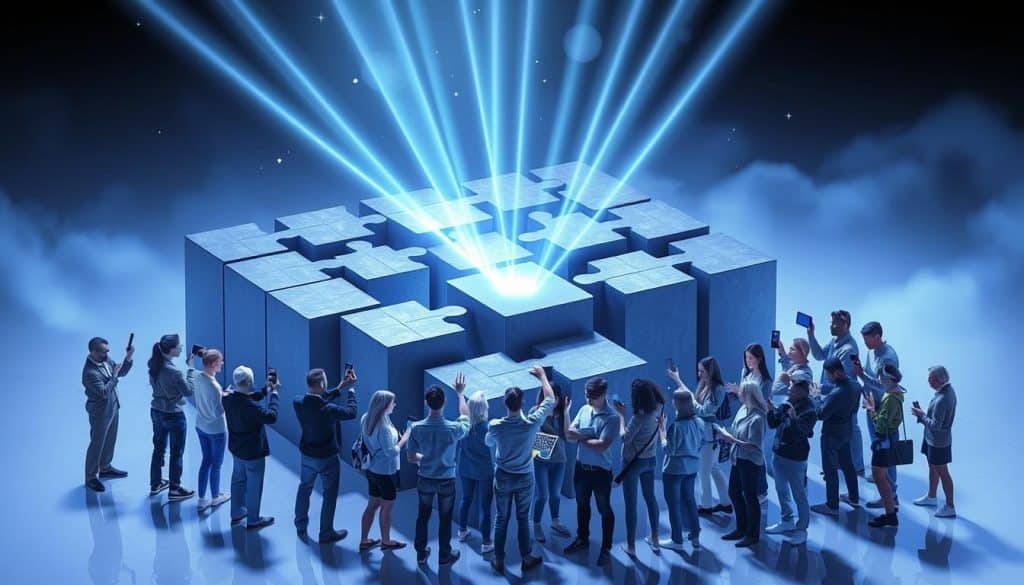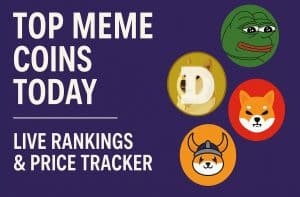The global blockchain market hit $17.57 billion in 2023. Experts predict it will surge to $469.49 billion by 2030. This means it could grow at an incredible rate of 59.9% each year1. Blockchain isn’t just trendy jargon. It’s a powerful tool that’s reshaping finance and secure investments in many areas1. In 2023, North America made up more than 40% of the blockchain market’s revenue2. This shows how crucial this region is to blockchain’s success2.
Blockchain is making things more transparent and changing fields from healthcare to farming. Big companies like IBM and Alibaba are leading the way in blockchain innovation2. By getting involved in blockchain now, you can tap into future earnings. Learn how this tech can protect your investments and lead to amazing growth.
Key Takeaways
- The global blockchain market is projected to grow from $17.57 billion in 2023 to $469.49 billion by 2030, with an average annual growth rate of 59.9%1.
- North America dominated the blockchain market in 2023, capturing over 40% of overall revenues2.
- Blockchain technology is driving financial growth and secure investments across multiple industries.
- Major companies like International Business Machines Corp. and Alibaba are leading the blockchain innovation2.
- Healthcare, real estate, and agriculture are among the industries significantly benefiting from blockchain technology.
Introduction to Blockchain Technology
Since 1991, blockchain technology has greatly changed the digital world. Its first major use was when Bitcoin started in January 20093. This tech ensures safe transactions and provides a digital record that cannot be changed. It has changed many areas like cryptocurrencies and more3.
Bitcoin began in 2009, leading to more use of blockchain. It showed how well blockchain can handle secure transactions3. The Bitcoin network is a key example of this tech. It had a huge processing power between May and June 2025. This power shows it’s very secure and strong3. Also, it’s very hard to attack big networks like Bitcoin because of blockchain’s design3.
Ethereum is another big name in blockchain. Over one million people trusted it enough to stake their ETH between April and June 20253. Schools and online platforms have started teaching about this tech. For example, Coursera has courses from the University of Buffalo on it4.
The University of California, Berkeley, also has a beginner’s course on edX. It covers Bitcoin and more4. Princeton University has a detailed course on Coursera as well. It looks at various aspects of cryptocurrencies4. The rise in these courses shows how important blockchain is for the future.
| Platform | Course | Focus Areas |
|---|---|---|
| Coursera | Blockchain Technology Series by University of Buffalo | Blockchain Basics, Smart Contracts, Decentralized Applications, Blockchain Platforms |
| edX | Blockchain Fundamentals by University of California, Berkeley | Bitcoin and Cryptocurrencies, Blockchain Technology |
| Princeton University (Coursera) | Bitcoin and Cryptocurrency Technologies | Decentralization, Mining, Anonymity, Regulatory Aspects |
Blockchain helps keep data safe and supports secure transactions. IBM offers a developers’ course on blockchain4. Cognitive Class has a course for those interested in learning the basics4. This shows how blockchain went from an idea to being widely used and important.
Benefits of Blockchain in Various Industries
Blockchain technology is making big changes in many areas by making things more clear, safe, easy to follow, and efficient. It’s changing the way things are done in fields from healthcare to farming.
Healthcare
Blockchain improves security in healthcare by safely holding patient details. This ensures medical records can’t be changed5. It helps keep privacy and lets people get to reliable data fast. Blockchain also makes it easier to follow where medicine supplies go. This helps follow rules and cuts mistakes in the supply chain5.
Real Estate
Blockchain changes how property ownership is tracked in real estate. It removes the middlemen by using a system that works on its own5. This makes transferring property easy and clear. Smart contracts in real estate cut costs by making some processes automatic5.
Retail
Blockchain helps retail support fair ways of making products. It makes everything more efficient and clear from the start to the customer6. Retailers can show their products are real. This cuts fraud and builds trust with shoppers6.
Agriculture
Blockchain helps track farm products from start to finish in agriculture. This makes the supply chain more clear and makes sure standards and safety rules are met6. The United Nations World Food Programme has used blockchain to give out food more efficiently. This cuts costs and gets food to those who need it quickly6.
| Industry | Blockchain Benefits | Examples |
|---|---|---|
| Healthcare | Improved security, traceability | Secure patient data, tamper-proof records |
| Real Estate | Increased efficiency, reduced costs | Dispute-free ownership tracking, smart contracts |
| Retail | Improved transparency, reduced fraud | Ethical consumerism, product authenticity |
| Agriculture | Increased efficiency, better compliance | Supply chain traceability, ethical standards |
How Blockchain Increases Transparency and Efficiency
Blockchain technology is changing many industries by greatly improving transparency and efficiency. Its features of being decentralized and unchangeable help make a trustless space. This is good for business7. Its network needs all users to agree to add new blocks, increasing trust. This reduces the need for central authorities to check transactions7.
Blockchain’s ledger technology lets us track transactions in real-time across many computers. This makes sure data can’t be changed and is easy to check8. For example, in retail, Walmart improved how it tracks food. This dropped the time to process info from days to seconds8.
In cybersecurity, having access to shared threat data lets companies check web attacks better. This reduces the chance of mistakes. It’s really helpful for fields that must follow strict rules, like GDPR or HIPAA. Here, blockchain helps keep things clear and avoids fines7.
Blockchain also helps marketing and sales by making sure customer reviews are real. It keeps a secure history of product changes. This approach stops one point from failing, making data more secure. It also makes customers trust the product more8.
A big plus of blockchain is that once data is there, it can’t be changed or attacked. This makes business deals more secure and reliable7. In industries with lots of rules, this clearness and safety help meet legal standards. This makes checking things easier and lessens legal troubles for not following rules7.
Blockchain brings many benefits to how things run. It helps businesses do better in efficiency and tracking while keeping data safe. To learn more about decentralized systems, see how they improve blockchain transparency.
| Key Benefits | Blockchain Attributes |
|---|---|
| Enhanced Transparency | Immutable and decentralized |
| Increased Efficiency | Streamlined operations and rapid data processing |
| Real-Time Tracking | Distributed ledger and tamper-proof data |
| Robust Security | Protection from modifications and attacks |
| Regulatory Compliance | Enhanced data visibility for audits |
Blockchain and Financial Inclusion
Blockchain technology changes how we use financial services. It helps include more people by providing access to those without bank accounts. Right now, about 1.7 billion people have no access to banking. Blockchain can help, especially in places like sub-Saharan Africa and Latin America. Here, 80% and 65% of adults don’t have bank accounts, respectively9.
Blockchain banking is great because it lowers the barriers for people to join the financial system. You don’t need a lot of money, credit history, or proof of where you live to start10. It allows people who are often left out to use new banking solutions efficiently. These include getting loans easily or making global payments without hassle10. Blockchain makes sure that anyone can make transactions safely and quickly10.
Having cryptos like stablecoins is key for financial inclusion. For example, USDC helps people in areas with high inflation save money safely. This way, they can protect their wealth from their local currency losing value10. Also, blockchain makes transactions cheaper. This means even small payments, which were once too costly, are now possible. This suits the everyday needs of those who are usually forgotten10.
Blockchain also offers wallets where users keep their own money safe, without needing a third party. This boosts their control and feeling of security with their funds10. By cutting out middlemen, blockchain allows for immediate transactions without trust issues. This makes crypto transactions cheaper10.
Using new stablecoins built on blockchain aims to make financial solutions open to everyone. It lets people send money internationally without big fees, securely and cheaply9. This tech is not just about making money management better for entrepreneurs. It also supports big goals, like those of the UN, by making financial inclusion a real thing we can achieve9.
Policies and rules from governments are important to make the most of cryptos. They help keep everything safe and stable10. As blockchain gets better, it creates a world where finance includes more people. This can really help communities around the world that don’t have enough support right now.
| Advantages | Description |
|---|---|
| Lower Barriers | No need for traditional banking requirements like credit history or minimum deposits10. |
| Lower Transaction Costs | Facilitates affordable microtransactions for marginalized communities10. |
| Self-Custody Wallets | Eliminates the need for third-party trust, enhancing financial security10. |
| Stablecoins | Maintains value in high-inflation markets, promoting financial stability9. |
| Instant Trustless Settlements | Lowers fees and minimizes intermediaries in financial transactions10. |
Smart Contracts: The Future of Digital Agreements
Smart contracts are contracts that run by themselves. They work on blockchain and follow the contract’s rules. This makes processes like payments automatic when certain conditions are met.
What are Smart Contracts?
Nick Szabo came up with smart contracts in the 1990s, starting a tech revolution11. Ethereum is a key player in smart contracts, showing its importance11. Smart contracts on blockchain bring security and transparency. They also keep transactions safe from unauthorized changes12.
Applications of Smart Contracts
Smart contracts have many uses, from finance to gaming12. Gala Games, for example, uses them for NFTs and rewards12. Gala Music uses them to give fans more power and handle music NFTs12.
Sonoco and IBM use smart contracts for safer medication transport13. Home Depot solves vendor issues faster with smart contracts13. They also make buying houses easier, cutting out the middleman13.
Looking ahead, smart contracts will work across different blockchains and may be legally recognized11. They’re key for automating business and using NFTs in decentralized apps11.
Blockchain Security: Keeping Transactions Safe
Today, keeping transactions safe is more important than ever. Blockchain technology steps up as a strong solution. It uses a system that spreads out data across multiple points, making it hard for hackers to break in14. This way, blockchain cuts down the risk of data being changed or attacked14.
Blockchain protects data using secret codes and group agreement processes14. This is great for fields like real estate and farming, where trust is key15. There are both public and private blockchains. Public ones keep users anonymous, and private ones check who you are to keep things secure14.
Blockchain’s popularity is on the rise. In the U.S., many people are open to using cryptocurrency for shopping, showing they trust blockchain15. Plus, lots of big banks are investing in blockchain, proving its reliability for secure transactions15.
However, blockchain isn’t perfect. Once, hackers took a lot of cryptocurrency, revealing weak spots in some wallet types16. There were also bugs in software contracts on the Ethereum blockchain that led to theft, showing the need for ongoing security updates16.
Still, blockchain’s setup is a strong guard against data theft. Bigger blockchain networks are harder to mess with, offering better protection14.
Below is a table comparing the key security aspects of public and private blockchains:
| Blockchain Type | Security Feature | Consensus Mechanism | Entry Restrictions | Anonymity |
|---|---|---|---|---|
| Public Blockchain | Decentralized, Tamper-resistant | Mining | Open to all | High |
| Private Blockchain | Permissioned, Selective Endorsement | Selective Endorsement | Restricted to known organizations | Low |
Blockchain is always getting better at keeping transactions safe. It gives amazing security and builds trust in many areas.
Hot Blockchain Opportunities in Cryptocurrency Trading
Cryptocurrency trading has grown thanks to AI and machine learning. Today, there are many trading bots designed for specific purposes. They help traders get more returns from their investments.
Rise of AI and Machine Learning in Trading Bots
AI has really changed how people trade cryptocurrencies. With machine learning bots, trading strategies get smarter using lots of data. For example, Cryptohopper uses AI to help traders decide with less effort17. These bots predict market trends, giving traders an advantage.
High-Frequency Trading (HFT) Bots
High-frequency trading bots move very fast. They make lots of trades in moments, using small market changes to earn profits. They work so quickly, faster than any person could. This helps a lot in fast-changing markets. Bigger investors and serious traders like these bots for their speed.
Arbitrage Bots
Arbitrage bots find price differences between exchanges. The crypto market’s huge size means there are many chances to make money18. These bots look at different exchanges at the same time for quick trades. Arbitrage is a good way to make steady money in this unpredictable market.
Sentiment Analysis Bots
Sentiment analysis bots also play a big part in crypto trading. They check what people say on social media and news to feel the market’s mood. This helps traders make smarter choices. Bitcoin, for example, is still very popular, with a 1.30% rise recently18. These bots give traders a heads-up on market moves.
These smart bots show how AI and automation are changing crypto trading. They make strategies better and help investors earn more.
The Role of Blockchain in Decentralized Finance (DeFi)
DeFi blockchain technology is changing the financial world fast. It allows for decentralized platforms without the need for middlemen. This technology makes financial services available to more people, creating a fairer financial system. With DeFi, users can do everything from borrowing and lending to trading and investing, all on blockchain networks.
At the heart of DeFi are decentralized platforms that cut out centralized institutions. This makes financial transactions between people more efficient and secure19. DeFi offers tools like decentralized exchanges and lending protocols. For example, Aave lets people supply or borrow liquidity, doing so without central control19.
DeFi stands for ‘open finance’. This means anyone with internet can use these financial services. Users can work out interest rates directly and manage their money by themselves20. DeFi uses smart contracts to make transactions open and trustworthy, creating a safer financial environment.
Another key part of DeFi is tokenized assets. This allows real-world assets to be represented on the blockchain. It opens up more financial markets to more people, improving liquidity and investment options. Ethereum is often used for these decentralized apps (dapps), including those for DeFi that support tokenized assets and help the ecosystem grow21.
DeFi has attracted over $100 billion in investment, showing its growing popularity and trust20. Liquid staking derivatives (LSDs) make staking more democratic. They let users trade staking tokens or cash them out straight from the contracts. This removes the need for a minimum amount to stake20.
Below is a summary table of how DeFi blockchain technology is making big changes in finance:
| Aspect | Details |
|---|---|
| Accessible Financial Services | Available worldwide for anyone with internet, with no geographic limits19. |
| Peer-to-Peer Transactions | Enables direct trading of cryptocurrency for goods or services19. |
| Tokenized Assets | Turns real-world assets into blockchain assets, boosting liquidity and investments21. |
| Innovative DeFi Protocols | Shows decentralized finance’s growth with over $100 billion invested in various apps20. |
| Liquid Staking | Makes staking more accessible by removing the need for a minimum stake20. |
Blockchain’s Impact on Supply Chain Management
Blockchain has changed supply chain management for the better. It offers more clarity, protection, and speed. The IBM Food Trust is a key example. This system uses supply chain blockchain to track food from farm to table. It ensures we can trace products, making consumers more confident.
IBM Food Trust
IBM Food Trust is a great example of blockchain’s benefits in managing supply chains. It keeps a permanent record of transactions. This provides instant information about the food’s quality, where it came from, and if it’s safe. Tracking products from start to finish lowers the risk of fake, tampered goods. It also makes the supply chain up to 20% more efficient. Warehouse, delivery, and resource costs can drop by almost 30%22.
Tracking and Authenticating Products
The main benefit of supply chain blockchain is how it tracks and proves product journeys. By saving transactions on a network, blockchain secures data. This data is hard to mess with23. Clearer view of supply chains leads to fewer middlemen. This cuts down on what companies spend on transactions23. Mixing blockchain with tech like AI and IoT could make supply chains even better. They could be more personalized and efficient22.
- Better visibility and tracing in supply chains23
- Less need for intermediaries, lowering transaction costs23
- Higher efficiency, with cost savings up to 30%22
| Aspect | Traditional Supply Chain | Blockchain-enabled Supply Chain |
|---|---|---|
| Transparency | Limited | High |
| Security | Moderate | Very High |
| Cost | High | Reduced |
| Efficiency | Variable | Improved by up to 20% |
| Product Authentication | Challenging | Simplified |
Reducing Corruption and Enhancing Voting Security with Blockchain
Blockchain tech can fight corruption and boost the trust in voting systems across the globe. Nations like Georgia have used blockchain to stop fake activities in land title registrations24. Secure blockchain voting systems are changing elections by cutting down risks and making governance clear.
Research by Liu and Wang in 2017, followed by Shahzad and Crowcroft in 2019, delved into blockchain’s role in voting. Their studies highlight the need for secure, clear, and efficient voting systems in our digital age24.
South Korea showed the world how blockchain-based voting can make elections more secure and transparent25. This move towards blockchain is seen globally as a way to secure the vote and protect democracy.
Also, 3 million overseas voters are part of the U.S.’s 200 million voters, with blockchain aiming to fix issues like absentee ballot rejection. Roughly 19,000 ballots were rejected in 2016 for being late25.
Blockchain’s decentralized nature means no one person can change voting data, building more trust in election results. The Swiss city of Zug had a successful small blockchain vote trial25. Likewise, Nasdaq’s blockchain vote trial in Estonia was well-received, showing blockchain’s growing acceptance in voting25.
Blockchain-based voting offers a big step forward in making elections safer and more transparent. It reduces fraud risks and leads to elections that people can trust more.
Integrating Blockchain with Luxury Goods and NFTs
Blockchain technology has changed how we verify luxury goods and NFTs. It helps confirm products are genuine and creates new ways for brands to make money. With NFTs, brands are quickly moving into the digital world26.
Digital Product Passports
Some brands, like Breitling, are using digital passports for their products. These passports use blockchain to keep a secure record of who owns a product and its history. They make sure the item is real and where it came from26.
Authenticating Luxury Goods
Fake luxury items cause huge losses for brands every year27. To fight this, more brands are turning to blockchain. For example, TARO ISHIDA uses NFTs to stop counterfeits and improve shopping for customers26. This use of NFTs makes everything more open and trusted, especially about who owns a digital item26.
Creating New Revenue Streams with NFTs
NFTs are making a big impact on the luxury industry by opening up new ways to earn money. Even though NFT prices have fallen lately, there’s still a big chance to profit. Brands like Adidas are getting into NFTs, reaching more people with special digital items and experiences27. The trend of combining physical and digital—’phygital’—shows how NFTs are becoming a key part of luxury and fashion26.
Environmental Concerns and Energy-Efficient Blockchain Solutions
Blockchain technology’s environmental impact, especially that of Proof-of-Work (PoW) systems like Bitcoin, worries many. This technology uses about 151 terawatt-hours (TWh) of electricity every year. That’s 0.59% of the electricity the whole world uses, creating around 55 million tons of CO2 emissions annually28.
Big cryptocurrency mining operations often set up in places with lots of cheap, reliable energy. This leads to a lot of mining in certain areas. The United States, China, and Kazakhstan are the top spots for Bitcoin mining, making up about 71% of the mining world2829.
To ease these environmental worries, moving to energy-saving ways to agree on transactions is key. Ethereum is changing from Proof-of-Work to Proof-of-Stake (PoS) with its Ethereum 2.0 update. This change could cut its energy use by up to 99%. Other unique ways like Proof-of-Authority (PoA) and Proof-of-Space (PoSpace) also lower energy use compared to PoW29.
Choosing eco-friendly blockchain solutions and using renewable energy can help lessen its carbon footprint. Some blockchain groups are looking into solar, wind, or water power for their operations. This aligns with global moves to fight climate change29.
Here is a comparison that shows these energy-efficient blockchain solutions:
| Consensus Mechanism | Energy Consumption | Environmental Impact | Example |
|---|---|---|---|
| Proof-of-Work (PoW) | High | Significant carbon emissions | Bitcoin |
| Proof-of-Stake (PoS) | Low | Reduced energy consumption | Ethereum 2.0 |
| Proof-of-Authority (PoA) | Moderate | Lower energy consumption | VeChain |
| Proof-of-Space (PoSpace) | Low | Minimal environmental impact | Chia |
By using sustainable practices and green technology, the blockchain sector can keep growing while cutting down on its environmental impact.
Mitigating the Social and Economic Impacts of Blockchain
Blockchain technology offers a path to economic fairness if used right. Yet, its adoption is not without hurdles. For example, the *total cryptocurrency market cap* hit about $254.67 billion with over 1,629 cryptocurrencies by early July 201830. This growth shows promise but also points to potential instability, seen in the high unpredictability of cryptocurrency markets31. Using stablecoins and fair blockchain methods can help lessen these risks32.
To make blockchain’s benefits accessible to all, strong risk management and clear laws are critical. Such laws must tackle *legal uncertainties* and moral worries. They should encourage standards, oversight, and educational resources that inspire innovation and critical thought32.
China is using blockchain to improve city living, focusing on governance and services31. This stands in contrast to global research that mixes blockchain with finance and cryptocurrencies31. To avoid widening financial gaps, we need careful policies and teamwork.
Blockchain’s promise reaches beyond money matters. It includes supply chains, legal records, and city management32. By offering widespread education and clear rules, we can embrace these chances. This promotes *economic inclusivity* and protects against misuse and chaos.
Read more on blockchain and economic.
We aim to use fair blockchain tech to spur inclusive growth. At the same time, we need solid laws to oversee its use. This way, we can tap into blockchain’s game-changing ability, reducing both social and economic challenges in the process32.
Blockchain’s Future Trends and Innovations
The future of blockchain technology is full of exciting advancements. We’re looking at innovation, quantum computing, and a focus on being green in crypto. These key trends will play a big role in shaping the industry.
Quantum Computing
Quantum computing will take blockchain to new heights. It will make blockchain networks super fast and super secure. This big step is important as the number of blockchain wallets has grown, hitting over 85 million in July 202333. Adding quantum computing means blockchain’s value might hit $3.1 trillion by 203033.
Sustainable Blockchain Solutions
Environmental worries are key for blockchain’s future. Efforts are being made to use energy better and create green blockchains. These eco-friendly blockchains lower carbon emissions and work in a planet-friendly way34. With blockchain’s market growing fast, North America led with 38% market share in 202233.
Collaborative Bots
Collaborative bots bring new solutions to blockchain. They use AI to better trading strategies by sharing information. This teamwork will make things cheaper and more efficient in many areas. For example, banks could save up to 30% of infrastructure costs, saving about $12 billion a year33. The use of blockchain across different sectors makes these bots very powerful for growth.
| Trend | Description | Impact |
|---|---|---|
| Quantum Computing | Integration to enhance processing capabilities | Enables faster and more secure networks |
| Sustainable Blockchain | Development of eco-friendly blockchain solutions | Reduces carbon footprint and energy consumption |
| Collaborative Bots | AI-driven bots optimizing trading | Increased efficiency and cost savings in banking |
Blockchain in Government Transactions and Public Services
Governments everywhere are getting into blockchain to make public services better. 90% of them plan to invest in this tech, seeing its huge benefits35. This interest comes from blockchain making things clearer and more reliable, which means a better-run government.
Estonia and South Korea show blockchain’s big impact. Estonia started digital voting in 2005 to improve safety and get more people voting36. South Korea tried blockchain voting in 2018 to make elections more dependable36. These efforts show blockchain’s power to make government innovation more transparent.

Blockchain is great for keeping government records too. It keeps them current, fights fraud, and adds clarity. This makes the public sector more responsible35. For example, some African countries use blockchain to keep public buying honest. This fights corruption which can steal up to 25% of a deal’s value36.
Since 2017, over 20 countries have tried blockchain tests35. They see its value in decentralizing and protecting important info. This makes stored data very secure and builds trust in government activities35.
Deloitte says blockchain could save banks $15-20 billion a year by 202235. This huge saving shows why lots of governments are using blockchain. It makes services smooth and cuts through complex government processes35.
| Country | Scandal/Initiative | Impact |
|---|---|---|
| Estonia | Digital Voting System | Increased voter turnout and security since 200536 |
| South Korea | Blockchain-based Voting Test | Enhanced electoral integrity in 201836 |
| African Countries | Public Procurement | Improved transparency and accountability36 |
Blockchain is really changing the game for public sector innovation. It’s making government work clearer. Places like Dubai are really leading in this area. This sets the stage for big changes in how the world’s public sectors work.
Conclusion
Today, blockchain technology is changing many industries in big ways. It makes financial transactions safer and supply chains more transparent. Companies like Walmart use blockchain to track food from farms to stores. This ensures everything is efficient and trustworthy37.
Blockchain is also making waves in healthcare and banking. For example, MedRec uses it for safe keeping of patient data. Meanwhile, Ripple makes money move across borders almost instantly37. There are great chances for investment in this tech. Especially as things like blockchain wallets become more user-friendly, despite some risks38.
Future blockchain updates aim to make it even safer and more useful. Things like biometric security and DeFi are game changers38. With tons of investors and venture capitalists ready to jump in, blockchain’s future is looking bright37. Joining this movement could change how our world works, economically and socially.
























 Bitcoin
Bitcoin  Ethereum
Ethereum  Tether
Tether  XRP
XRP  USDC
USDC  Wrapped SOL
Wrapped SOL  Lido Staked Ether
Lido Staked Ether  TRON
TRON  Dogecoin
Dogecoin  Cardano
Cardano  Figure Heloc
Figure Heloc  WhiteBIT Coin
WhiteBIT Coin  Wrapped stETH
Wrapped stETH  Bitcoin Cash
Bitcoin Cash  Wrapped Bitcoin
Wrapped Bitcoin  Chainlink
Chainlink  USDS
USDS  Hyperliquid
Hyperliquid  LEO Token
LEO Token  Binance Bridged USDT (BNB Smart Chain)
Binance Bridged USDT (BNB Smart Chain)  WETH
WETH  Stellar
Stellar  Wrapped eETH
Wrapped eETH  Monero
Monero  Ethena USDe
Ethena USDe  Coinbase Wrapped BTC
Coinbase Wrapped BTC  Litecoin
Litecoin  Zcash
Zcash  Avalanche
Avalanche  Sui
Sui  Hedera
Hedera  Shiba Inu
Shiba Inu  Dai
Dai  sUSDS
sUSDS  World Liberty Financial
World Liberty Financial  Cronos
Cronos  USDT0
USDT0  Toncoin
Toncoin  PayPal USD
PayPal USD  Uniswap
Uniswap  Polkadot
Polkadot  Ethena Staked USDe
Ethena Staked USDe  Mantle
Mantle  Aave
Aave  Bittensor
Bittensor  USD1
USD1  Canton
Canton  Bitget Token
Bitget Token